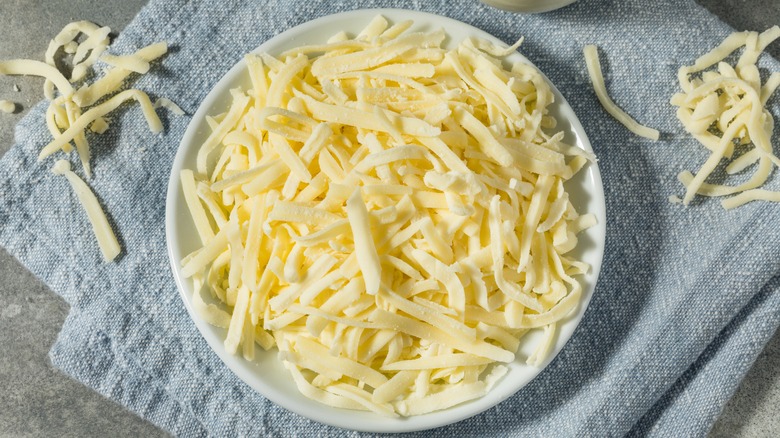Ever Wonder What The Powdered Substance On Shredded Cheese Is?
The powdered substance found in bags of pre-shredded cheese is an anti-caking agent. It's included to prevent the contents from sticking together and to absorb excess moisture, which helps prevent molding. Typically, this substance is one of two things: cellulose gum or a starch blend.
Cellulose gum, also known as carboxymethyl cellulose (CMC), is a type of plant pulp treated with acetic acid, often vinegar. While it's often derived from wood pulp, don't let the idea of "eating sawdust" turn you off. Cellulose exists in every plant, but extracting it destroys the plant, so deriving cellulose from onions or celery would waste a perfectly good vegetable. This is why the cellulose in cellulose gum is often derived from plant waste, like cotton lint or wood bark.
Like cellulose gum, starch also affects moisture and caking. Unlike cellulose gum, starch comes from cheap, high-yield crops like potatoes or tapioca. Both starch and cellulose gum fulfill the same goal of preventing clumps and absorbing moisture, so why do some companies opt for starch over CMC?
A 2020 study conducted by North Carolina State University found little difference in consumer perception of three common anti-caking agents, except that potato starch scored significantly higher with testing groups in handling and appearance when cold. As a result, pre-shredded cheese using potato starch simply looks better in the store and feels better when cooked, leading more people to purchase it.
Does anti-caking powder affect how pre-shredded cheese melts?
One of the most common complaints about pre-shredded cheese is that the powder affects how the cheese melts. Moisture is a key element in how any cheese melts, from high-moisture mozzarella to low-moisture cheddar, because cheese melts when its proteins are exposed to heat, lose water, and reform into stronger bonds.
Both cellulose gum and starch are thickening agents that absorb water, which means they prevent protein molecules in melted cheese from forming clumps as they heat up. Chefs may add starch to cheeses that don't melt well, like cheddar, when incorporating them into sauces, such as a roux for macaroni and cheese. While a starch's main job in a macaroni and cheese roux is to thicken the sauce, it also prevents the cheese from becoming stringy and runny.
However, for something like a grilled cheese or an English toastie, you want your cheese to retain some moisture. Grilled cheese sandwiches have short cooking times, meaning the cheese is exposed to less heat. Cheese with higher moisture content can properly melt and flow at lower temperatures as its protein structures break apart. This high moisture content, coupled with weak protein structures, is why melted cheeses like Colby jack and mozzarella create their signature long strands when pulled apart.
So, while the anti-caking powder in pre-shredded cheese does affect how it melts, it's not necessarily a bad thing. If you need lots of freshly shredded cheese, try this easy, mess-free cheese grater hack. But sometimes, the convenience of pre-shredded cheese wins out.


